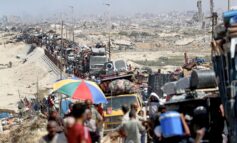U.S. boosts aid amid doubts about Pakistan’s recovery
WASHINGTON (IPS) — The administration of U.S. President Barack Obama has announced it will provide an additional 75 million dollars in food aid to help Pakistan cope with floods that have affected about one-fifth of the country – including some 20 million people – since they began in July.

|
| A woman displaced by flooding carries a jug of milk as she wades through floodwaters to return to her flooded village of Bello Patan in Pakistan’s Sindh province on September 22, 2010. REUTERS/Akhtar Soomro |
The additional assistance was announced in the wake of an unprecedented appeal Friday by U.N. Secretary-General Ban Ki-moon for two billion dollars in flood relief this year, a four-fold increase in what the U.N. had requested in the first half of August as the floods swept from the frontier regions high in the Himalayas through the Punjab, eastern Baluchistan and Sindh into the Arabian Sea.
The U.N. appeal was reportedly the largest related to a natural disaster ever made by the world body, exceeding by 500 million dollars the appeal issued on Haiti’s behalf after that country’s devastating earthquake last January.
In announcing the new assistance, Washington’s special envoy to Afghanistan and Pakistan, Ambassador Richard Holbrooke, predicted that the recovery and reconstruction costs will far exceed the funding that other countries and international institutions can be expected to provide.
“The international community is not going to be able to pick up the full costs of the reconstruction phase,” he said, adding that the ultimate costs will run to the “tens of billions of dollars.”
“The international community has been quite generous already on rescue and early recovery, and no one more generous than the United States,” he said, adding that the total amount of external funding “will be only a fraction of what’s needed.”
Asked whether there was enough money in Pakistan to finance reconstruction, Holbrooke said “that’s a question we all ask ourselves – nobody knows. But one thing that seems very likely is that the answer to your question is ‘probably not.'”
“The Pakistanis are going to have to find a way to enhance their own revenue,” he went on, echoing a point made by both Secretary of State Hillary Clinton and World Bank President Robert Zoellick at a ministerial meeting on the flood emergency in Pakistan held at U.N. headquarters in New York Sunday.
“Pakistan’s (tax) revenue has amounted to about nine percent of the GDP (gross domestic product),” Zoellick said. “This is pretty low by international standards. We need Pakistanis to pay for Pakistan if we are to mobilize the world to pay for Pakistan.”
He also called on Islamabad to take “concrete steps, backed by law,” to ensure greater transparency and accountability in handling reconstruction funds before a donors’ meeting in Brussels next month.
This year’s floods, the worst in the nation’s history, have dealt a serious blow to U.S. hopes for stabilizing the country’s civilian-led government and focusing its powerful army on fighting the Pakistan’s own Taliban insurgency along the Afghan border that is closely allied to both al Qaeda and the Afghan Taliban.
While both Holbrooke, who just returned from Pakistan, and Rajiv Shah, the administrator of the U.S. Agency for International Development (USAID), insisted Monday that the civilian government was proving effective in the relief effort, published reports from the flood-affected areas over the past month have repeatedly quoted the deluge’s poorer victims and refugees complaining about the failure of civilian officials to provide assistance or even to show up.
And, while President Asif Ali Zardari has since traveled to flood-affected regions, his initial response – to carry through with a long-planned trip to Europe – has reportedly brought his already-dismal public-approval ratings to unprecedented lows.
In his remarks, Holbrooke said that the lead should be taken by the military, which he described as the “tightest organic organization in the country” and the only institution with the “ability to deploy large numbers of people immediately.”
With the military engaged in rescue and relief operations, however, its ability to fight a full-scale counter-insurgency campaign against the Taliban, at least in the immediate term, has been significantly reduced, according to experts here and in Pakistan.
About half of the some 150,000 troops deployed to the frontier areas – as well as scores of helicopters – were diverted to relief operations in the early stages of the emergency, while U.S. military strategists, already sceptical about the willingness of their Pakistani counterparts to launch a long-sought offensive in North Waziristan, which is thought to shelter the Husseini faction of the Afghan Taliban, as well as senior al Qaeda leaders, appear to have given up on the idea.
Meanwhile, the flow of impoverished and desperate refugees from the northwest and Baluchistan into already-crowded metropolises, such as Karachi, has reportedly heightened pre-existing ethnic tensions that have often boiled over into violence.
“As someone who has visited Pakistan often over the past year, I worry that the country is nearing the tipping point – a moment when the multiple pressures overwhelm the government’s ability to cope and Pakistan borders on becoming a failed state,” wrote David Ignatius, the influential Washington Post columnist who is considered close to foreign policy greybeards, such as former national security advisers Brent Scowcroft and Zbigniew Brzezinski, late last month.
Arnaud de Borchgrave, a well-connected UPI veteran, warned of a “nightmare scenario” of a coup that would bring “younger Islamist officers” to power in the “world’s first failed nuclear state” in another op-ed published earlier this month.
While the official U.S. view is considerably less dire, officials privately admit that Washington’s strategy for both defeating the Taliban insurgency and boosting economic growth through development assistance and preferential trade arrangements in critical parts of the country has been overwhelmed. Among other things, the catastrophe has destroyed much of the affected regions’ physical infrastructure, including roads, bridges, schools, hospitals, not to mention more than 1.8 million homes and much of its livestock on which millions of households depend.
Congress last year approved a five-year, 7.5-billion-dollar economic aid package for Pakistan of which the first installment of 1.5 billion dollars is to be spent this year. While that money was designed primarily to improve agricultural productivity and upgrade existing power plants, much of it, including most of the emergency aid provided so far, will now likely be re-programmed to support the relief and recovery effort, according to officials here.
The 75 million dollars in food aid announced Monday will be in addition to the 1.5 billion dollars, according to Shah. Moreover, in a significant break from traditional requirements, only five million dollars worth of the new food aid will be shipped from the U.S. The rest will be purchased from existing stockpiles in Pakistan.






Leave a Reply